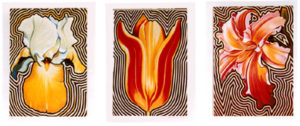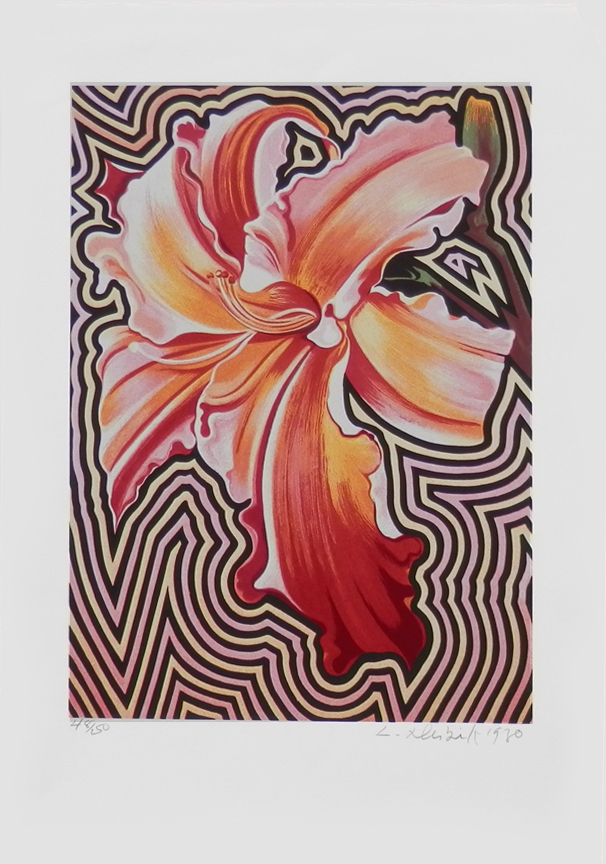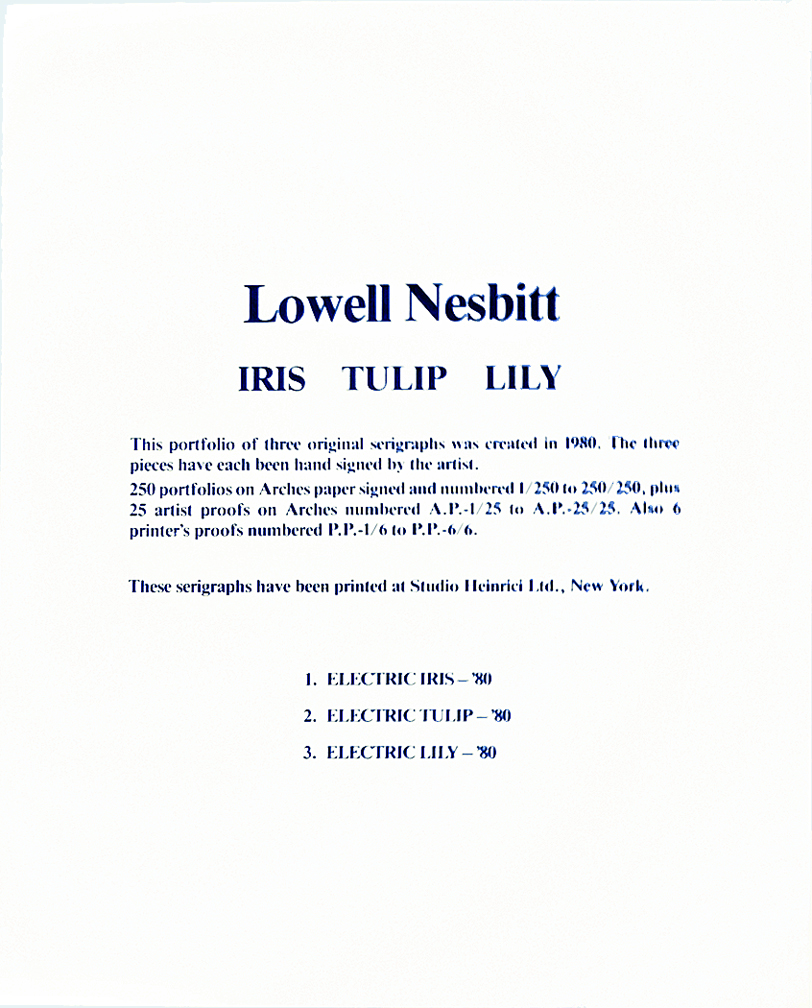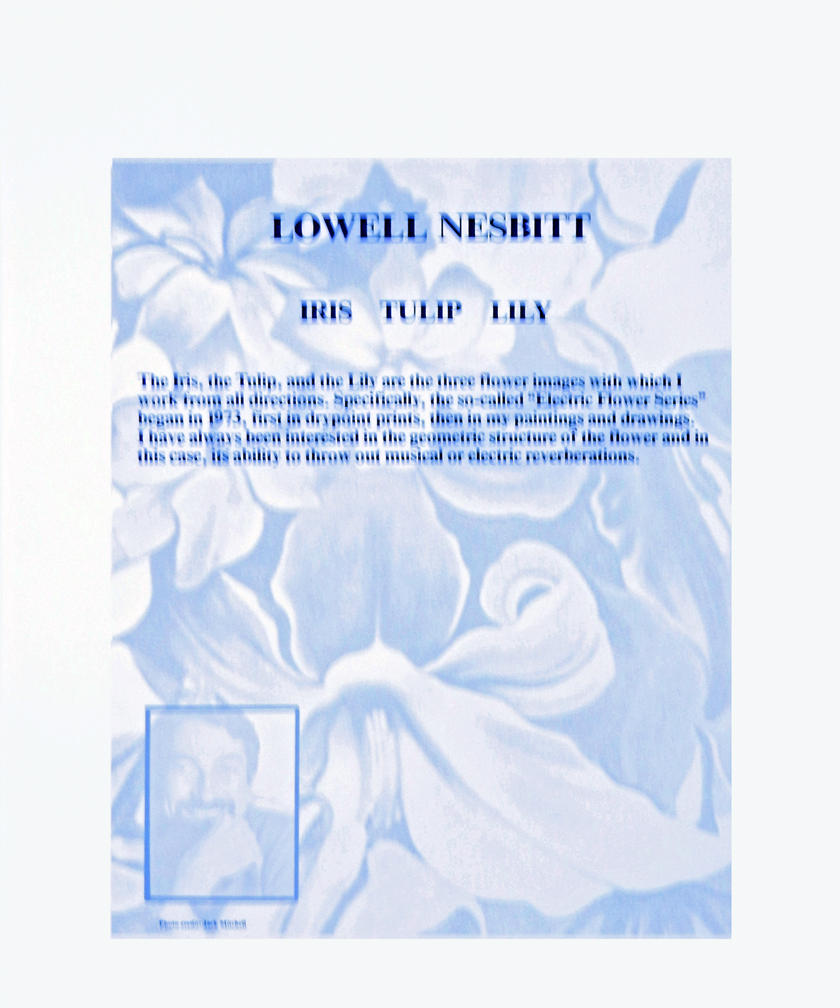Description
ELECTRIC IRIS, TULIP, LILY by Lowell Nesbitt
MAKE AN OFFER
All reasonable offers will be considered
$2,700.00 – (Sale Price $1,800.00)
ELECTRIC IRIS, TULIP, LILY by Lowell Nesbitt is a suite of three (3) serigraphs from a limited edition of 250. The image size of each print is 16” X 11 1/4” plus full margins. The year of publication was 1980. These three (3) prints are pencil signed and numbered by the artist.
The full tirage includes 250 portfolios on Arches paper signed and numbered 1/250 to 250/250, plus 25 artist’s proofs on Arches numbered A.P.-1/25 to A.P.-25/25. Also 6 printer’s proofs numbered P.P.-1/6 to P.P.-6/6.
Lowell Nesbitt’s artwork is owned by hundreds of public collections worldwide. A number vastly too extensive to include within this ‘Description’. These prints are in excellent condition and have not been framed or mounted.
THE ARTIST SPEAKS ABOUT THESE THREE PRINTS
These three beautiful prints come in a hard cover portfolio and include full tirage information and text by the artist as follows:
“The Iris, the Tulip and the Lily are the three flower images with which I work from all directions. Specifically, the so-called “Electric Flower Series” began in 1973, first in dry point prints, then in my paintings and drawings. I have always been interested in the geometric structure of the flower and in this case, its ability to throw out musical or electric reverberations.”
ARTIST LIMITED BIOGRAPHY
Lowell Blair Nesbitt (October 4, 1933 – July 8, 1993) was an American painter, draughtsman, printmaker, and sculpture. He served as the official artist for the NASA Apollo 9, and Apollo 13 space missions; in 1976 the United States Navy commissioned him to paint a mural in the administration building on Treasure Island spanning 26 feet x 251 feet, then the largest mural in the United States; and in 1980 the United States Postal Service honored Lowell Nesbitt by issuing four postage stamps depicting his paintings.
In 1958 the Baltimore Museum of Art hosted the first solo museum exhibit that Nesbitt was to have in his lengthy career, but it was in 1964 with his debut at the Corcoran Gallery of Art (Museum) in Washington D.C. that Nesbitt received greater recognition. Nesbitt was often classified as a Photorealist artist, though he fought inclusion with this group of artists throughout his career. Nesbitt established himself as an artist who could employ both diversity of technique and subject matter while creating paintings, drawings and prints.
To honor Nesbitt’s contributions to the art world, in 1980, the United States Postal Service issued four stamps based on his floral paintings. He also served as the official artist for the NASA space flights of Apollo 9 and Apollo 13. Nesbitt was found dead in his New York studio in 1993 at the age of 59. Police stated he died of natural causes.

Electric Iris

ELECTRIC IRIS, TULIP, LILY by Lowell Nesbitt
MAKE AN OFFER
All reasonable offers will be considered
$2,700.00 – (Sale Price $1,800.00)
ELECTRIC IRIS, TULIP, LILY by Lowell Nesbitt is a suite of three (3) serigraphs from a limited edition of 250. The image size of each print is 16” X 11 1/4” plus full margins. The year of publication was 1980. These three (3) prints are pencil signed and numbered by the artist.
The full tirage includes 250 portfolios on Arches paper signed and numbered 1/250 to 250/250, plus 25 artist’s proofs on Arches numbered A.P.-1/25 to A.P.-25/25. Also 6 printer’s proofs numbered P.P.-1/6 to P.P.-6/6.
Lowell Nesbitt’s artwork is owned by hundreds of public collections worldwide. A number vastly too extensive to include within this ‘Description’. These prints are in excellent condition and have not been framed or mounted.
THE ARTIST SPEAKS ABOUT THESE THREE PRINTS
These three beautiful prints come in a hard cover portfolio and include full tirage information and text by the artist as follows:
“The Iris, the Tulip and the Lily are the three flower images with which I work from all directions. Specifically, the so-called “Electric Flower Series” began in 1973, first in dry point prints, then in my paintings and drawings. I have always been interested in the geometric structure of the flower and in this case, its ability to throw out musical or electric reverberations.”
ARTIST LIMITED BIOGRAPHY
Lowell Blair Nesbitt (October 4, 1933 – July 8, 1993) was an American painter, draughtsman, printmaker, and sculpture. He served as the official artist for the NASA Apollo 9, and Apollo 13 space missions; in 1976 the United States Navy commissioned him to paint a mural in the administration building on Treasure Island spanning 26 feet x 251 feet, then the largest mural in the United States; and in 1980 the United States Postal Service honored Lowell Nesbitt by issuing four postage stamps depicting his paintings.
In 1958 the Baltimore Museum of Art hosted the first solo museum exhibit that Nesbitt was to have in his lengthy career, but it was in 1964 with his debut at the Corcoran Gallery of Art (Museum) in Washington D.C. that Nesbitt received greater recognition. Nesbitt was often classified as a Photorealist artist, though he fought inclusion with this group of artists throughout his career. Nesbitt established himself as an artist who could employ both diversity of technique and subject matter while creating paintings, drawings and prints.
To honor Nesbitt’s contributions to the art world, in 1980, the United States Postal Service issued four stamps based on his floral paintings. He also served as the official artist for the NASA space flights of Apollo 9 and Apollo 13. Nesbitt was found dead in his New York studio in 1993 at the age of 59. Police stated he died of natural causes.








